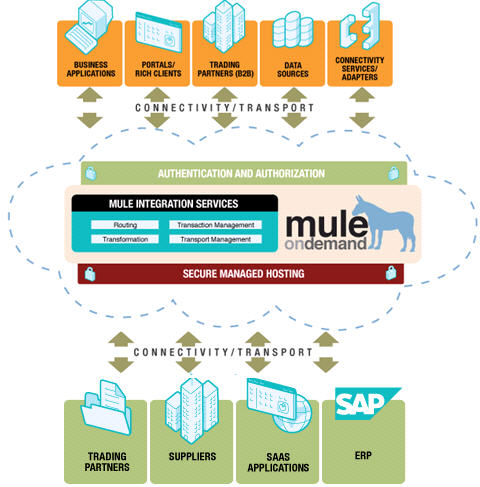MuleSource brings its ESB platform to the cloud

MuleSource is entering the on demand space with a hosted version of its open source enterprise service bus and integration platform. MuleOnDemand supports a multitude of APIs, frameworks and transports--such as Web Services, MQ Series, JMS, HTTP, REST, SOAP and email--for integrating systems with enterprise applications.
MuleOnDemand can be used as a ESB-in-the-cloud service or connected to a Mule Gateway server within an enterprise. The company will be showing hosted integration with salesforce.com at the the Dreamforce 07 conference this week. For example, MuleSource receives an email and CSV, transforms the CSV data and then updates the salesforce record via an API.
The Gateway server, which is currently in private beta with several customers is hosted at customer sites and acts as the broker between the resident infrastructure and MuleOnDemand. For example, a Mule Gateway behind the firewall connected to MuleOnDemand could be used to transform, route and process outbound wire transfers for financial institutions, or to transform CSV to XML for trading partners.
The MuleOnDemand platform is expected to be generally available in mid-October, according to MuleSource CEO Dave Rosenberg.
As an open source upstart, MuleSource is focused on disrupting the ESB and integration space as Red Hat and MySQL have done in their respective arenas. "In the open source space you still have guys fighting on the playground," Rosenberg said. "We are going after Tibco, IBM, Oracle and BEA." H&R Block replaced its Tibco solution with MuleSource for its 13,000 stores, he added.
The chart below shows MuleSource's view of the cost for an ESB integration solution. The cost advantages of open source MuleSource seem unreal--from 1 to 15 percent less than competitive tools.
MuleSource charges for support services only, although it does provide some proprietary tools for interface development in the commercial version. MuleOnDemand pricing has not been set, but it could be tiered based on the number of transactions, Rosenberg said.
MuleSource's momentum is best captured in the 1 million downloads of the open source code. Sixty percent of Mule users create extensions and plug-ins. Earlier this month, the company launched MuleForge, a collaborative development site for Mule extensions and applications built by the Mule community. It also provides some automation for building, testing and compiling code.
"People are figuring out that open source is working, and the next generation of enterprise software doesn't have boundaries," Rosenberg said.
The company currently has 43 employees distributed across 9 countries, and has been bankrolled with $16.5 million by Hummer Winblad, Lightspeed Ventures and Morgenthaler Ventures. The company recently hired Jim Emerich as vice-president and chief financial officer. He was most recently senior vice president of internal audit at salesforce.com and held several other positions, including interim CFO, during his six years at the company.
MuleSource has only a handful of customers to date, but as the company gains more momentum and an ability to support more Fortune 500 customers, the incumbents will have to rethink their pricing and product offerings.
